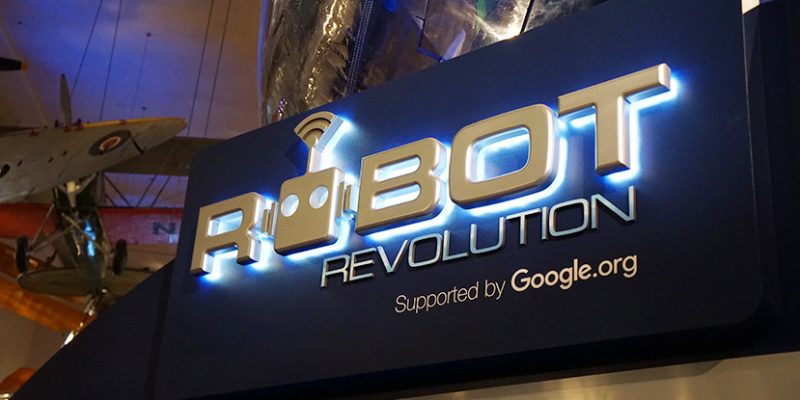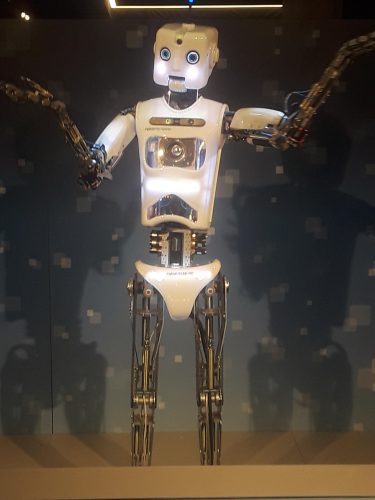It is said in the book of Genesis that God created man in the likeness of his own image. But if you visit the Robot Revolution exhibit at Chicago’s Museum of Science and Industry, you will see that humans are now creating their own self-replicating beings, with more awe-inspiring detail than ever before.
“I think it’s really interesting how the robots are actually so evolved. Technology is definitely further than I thought it was. And I find it particularly interesting to see how everything works, and what has become possible,” said Freija Van Lent, a guest at the museum who gazed at a group of robots that were playing soccer.
The exhibit doesn’t only feature robots that are designed to emulate humans, at least visually. Some designs reflect animals, and others hardly resemble a living creature at all. However, all the robots present at the exhibit have at least three fundamental characteristics in common: they can all sense, plan and act. However, according to director of exhibit design and development, John Beckman, the robotics industry is a work in progress but it’s certainly growing rapidly.

(Photo courtesy of Museum of Science and Industry)
“Robots will be becoming more and more prevalent in the future. As you see them in the exhibit, they’re separated into cooperation, skills, smarts and locomotion. Some do a little bit better in one than the others, but a lot of them have elements of each. They just haven’t quite gelled yet. But sometimes like in manufacturing, they are very reliable and very helpful. Walking around your house and helping you with things, so we’re getting pretty close,” Beckman said.
Interestingly enough, the exhibit provides very little historical context with regards to robotic development. Beckman explains that they want the focus to be on technology’s current state, and what could lie ahead in the future based on the current attributes of their robots.
“One of the things we wanted to do at the exhibit, is you’ll see very little history in the exhibit, in order to show you specifically where we’re at right now, and hopefully open that sort of line of questioning in your mind and say, ‘well, if a robot can do this, I wonder, if it can do that,” Beckman said. “Or if it can do this and this, I would make it do that.’ So even for the industrial robots and some of the stuff, we’ve arranged the exhibit by those attributes rather than the applications.”
Beckman credits many technological advances that have helped move robotics further along, including the Microsoft Kinect, which revolutionized the industry.

(David P. Stein/The DePaulia)
“Some of the things that have happened lately, have been a huge help. The devices that are in our phones, gyroscopes, accelerometers, are now made smaller and cheaper, and that makes a huge difference in terms of making a robot more aware of itself and its surroundings,” Beckman said. “The Microsoft Kinect, while everybody was enjoying playing games in their basement, quietly revolutionized university level robotics because you could just basically strap one to the top of pretty much any robot you had, and suddenly you have a very sophisticated vision system, where that was really hard before.”
Another interesting detail about how the robots operate and progress is that, like humans, they learn and evolve based on the environment they are in.
“Actually, people look a lot at childhood development in how you teach a robot be smart. Are we really talking about AI and intelligence?” Beckman said. “Well, you gotta give them a little bit before you give them the next bit, before you give them the next bit.”
But despite all these incredible technological advances that are being made, Beckman assures many of the exhibit’s guests that we are still a ways away from any sort of robot apocalypse.
“If anyone was worried about a robot apocalypse, keep in mind that we’ve got three robot specialists. Two of whom are on duty at any given time. Just to keep everything working. It’s a daily challenge,” he said.
One of Beckman’s robot specialists, Adrian Choy, has been working in robotics for the past 10 years. He says that every single day at the museum is different, and unpredictable.
“So there’s really not a typical day in this exhibit, so we don’t really stick to a specific schedule. My job is to lead the team logistically. At the very least, we do the routine stuff for our robots. We turn them on in the morning. It takes about an hour just to get all 40 of our robots up and running. We do at least 100 battery changes a day with our robots, and we have a feeding schedule,” Choy said.
“And then the unexpected errors that could happen, like mechanical failures, changes in programming that need to be done, and it’s always a constant challenge because there’s no routine maintenance that we can really predict, because as robots age, problems are always changing.”
While the Judeo-Christian bible encourages humans to be fruitful and multiply, it is clear that those in the robotics industry have their own objectives when it comes to procreation.

